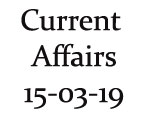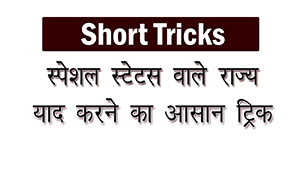-
Current Affairs15th March 2019
Updated : 15-Mar-2019
Current Affairs 15th March 2019 - Important Points
- New visa pact between India, Maldives comes into effect on - 11th March 2019
- Mohammad Shtayyeh named as new Palestinian Prime Minister on - 10th March 2019
- President Ram Nath Kovind launched nationwide Pulse Polio Program 2019 - 9th March 2019
- State Governments allowed to put Enemy Properties to Public Use by - Centre
- 50th Raising Day celebrations of CISF by - PM Narendra Modi
- University for Peace Confers Honorary Doctorate on - Vice President Venkaiah Naidu
- Who has been appointed as Chancellor of Gujarat Central University ? - Hasmukh Adhia
Current Affairs 15th March 2019 - Details
New visa pact between India, Maldives comes into effect on - 11th March 2019
The new visa pact between India and Maldives, giving a liberal visa policy for Maldivian residents seeking medical treatment and education along with business opportunities in India, came into force on March 11th, 2019.
The pact has come into effect following all regulations including data being provided to all immigration offices, border points and customs authorities have been finished.
India and Maldives had exchanged diplomatic records for the execution of the visa facilitation pact in February 2019, following the approval by the Union Cabinet.
The main objective behind the initiative is to enhance people-to-people relations between the two nations.
Key Highlights- The new visa pact delivers a very liberal visa command for Maldivian nationals to visit India for tourism, business, education and medical reasons.
- It also makes it relaxed for Indians to travel to the Maldives for business motives.
- Under the pact, Maldivian businessmen and tourists can visit in India for 90 days without a visa.
- The Maldivian tourists with tourist visas can also stay in India for treatment if they suffer a rapid medical issue.
Mohammad Shtayyeh named as new Palestinian Prime Minister on - 10th March 2019
Mohammad Shtayyeh was termed as the new PM of Palestine by the President of Palestinian Authority
Mahmoud Abbas on March 10th, 2019. Shtayyeh is the member of the central committee of the President’s Fatah party.
He was acknowledged by the President at his office on March 10th and asked to formulate the new government. Shtayyeh replaces Rami Hamdallah, who had been PM since 2014.
More about Mohammad Shtayyeh- Shtayyeh born in Nablus in the West Bank in 1958, and was 9 years old when Israel apprehended the territory during the 6-Day War, an occupation that continues even now.
- Shtayyeh studied at Birzeit University in the West Bank and finished a Ph.D. in development at Sussex University, Britain and then came back to the Palestinian territory in the late 1980s.
- Shtayyeh has devoted much of his life working alongside Abbas. He is a political moderate and a strong supporter of the 2-state solution, which calls for the formation of an independent Palestinian state together with Israel.
- He has worked as a minister twice in the earlier Palestinian governments, and grasped major roles in economic progress initiatives as well as the Palestinian Economic Council for Development and Reconstruction.
President Ram Nath Kovind launched nationwide Pulse Polio Program 2019 - 9th March 2019
President Ram Nath Kovind on March 9th, 2019 released the Pulse Polio program 2019 by directing polio drops to children less than 5 years old at the Rahstrapati Bhawan. The President directed the polio drops on the eve of the National Immunisation Day which is celebrated on 10th March every year.
More about Pulse Polio Immunization Program- The Pulse Polio Immunisation Program was started in India in 1995 with the purpose of eradicating polio completely from the nation.
- The program was released under the WHO’s Global Polio Eradication Initiative.
- Under this program, every child below 5 years in age is given 2 doses of Oral Polio Vaccine, in the month of January and December every year and it wishes to be continued till Polio is eradicated entirely.
- It purposes to reach unreached children via improved social mobilization, mop-up operations in areas where poliovirus has almost vanished and maintain high level of morale among the community.
Initiatives released by Government
The Government has also released the Universal Immunisation Program to safeguard children from other diseases and announced several new vaccines including Pneumococcal Conjugate Vaccine, Rotavirus vaccine, and Measles-Rubella vaccines.
To deliver extra protection to children, the Government introduced the injectable “Inactivated Polio Vaccine” into its routine immunisation program.
Along with the Universal Immunisation Program of the nation, the government also released the Mission Indradhanush to fast-track goal to accomplish above 90% full immunisation coverage.
Above 3.39 crore children and 87 lakh pregnant females have been vaccinated via Mission Indradhanush drives.
State Governments allowed to put Enemy Properties to Public Use by - Centre
The central government has permitted the state governments to consider enemy properties into public
usage. The central government has revised the norms for disposal of the Enemy Property Order, 2018, to simplify use of enemy property by the state government completely for public use.
Enemy Properties
Enemy properties are those properties of the people who moved to Pakistan during partition and also to
China following the Sino-India war in 1962.
It is believed that there are 9280 such properties which were left behind by individuals who left for
Pakistan and 126 such properties were left by the Chinese residents.
Of the total properties left behind by those moved to Pakistan, around 4991 are situated in UP, the
highest in the nation and West Bengal has 2735 such estates and Delhi 487.
Of the total properties left by those moved to China around 57 properties are located in Meghalaya,
highest in the nation. West Bengal has 29 such properties and Assam 7.
The approximated value of all enemy properties is about Rupees One lakh crore.
The government had passed the Enemy Property Act in 1968. This act was further amended through the Enemy Property (Amendment and Validation) Act, 2017.
Model Code of Conduct Started
With the Election Commission of India declaring the polling dates for the 2019 Lok Sabha Elections, the Model Code of Conduct has come into the effect.
Model Code of Conduct- Model Code of Conduct mentions to a set of norms published by the Election Commission of India to regulate political parties and candidates before elections.
- A version of Model code of conduct was 1st announced in the assembly elections in Kerala in 1960. These norms were largely trailed by the political parties during the 1962 Lok Sabha Elections.
- Further in 1979 the Election Commission of India added a section to regulate the party in power and avert it from gaining an unfair advantage at the time of elections.
- Model Code of Conduct comes into force from the date the election list is declared and will be in effect until the date that results are out.
- Model Code of Conduct contains 8 necessities tackling general conduct, assemblies, processions, polling day, polling booths, observers, the party in power, and election strategies.
- As soon as the Model Code of Conduct kicks in, the central and state governments are restricted to make sure that they don’t utilise their certified position and status for campaigning.
- Those in power cannot associate their formal visits with those related to campaigning for the motive of elections.
- The biggest drawback of the Model Code of Conduct is lack of statutory backing.
- This executes limitations on Election Commission to move against those violating the norms of Model Code of Conduct.
50th Raising Day celebrations of CISF by - PM Narendra Modi
PM Narendra Modi witnessed the 50th Raising Day celebrations of CISF, at Indirapuram, Ghaziabad, UP.
Praising the role of Central Industrial Security Forces in developing New India by providing security to
the dynamic institutions of the nation, PM recommended the idea of initiating digital museums at
airports and metros, displaying the work of Central Industrial Security Forces.
Central Industrial Security Forces- CISF came into existence in 1969 with 3 battalions, to deliver combined security to the PSUs which,
employed the impressive heights of the economy. - Over the years Central Industrial Security Forces has expanded several folds to reach 148371 staffs
today. - With the Indian economy initiating for globalisation, Central Industrial Security Forces is no more a
Public Sector Undertaking centric organisation. - It has engraved a niche for itself as a premier multi-skilled security agency of the nation, authorized to provide security to major critical infrastructure installations of the nation including those in the private sector.
- Together with operating critical and vital installations of the nation, Central Industrial Security Forces has also emerged as a force to estimate during disasters specially during Kerala floods and also during Nepal and Haiti earthquake.
University for Peace Confers Honorary Doctorate on - Vice President Venkaiah Naidu
Vice President Venkaiah Naidu was honoured Honorary Doctorate from the United Nations recognized
University of Peace. The university has specified that the degree of ‘Doctor Honoris Causa’-(Doctor of
Philosophy) was bestowed on the Indian Vice President recognising his contribution to the Rule of Law,
democracy and sustainable development in India.
Vice President Venkaiah Naidu is the 1st Indian to take an honorary doctorate from the University of
Peace.
University of Peace
The University of Peace was recognized in accordance with the Resolution 35/55 approved by the UN
General Assembly in 1980. The main campus of the University of Peace is situated in Costa Rica, Central America.The University of Peace goals to be a forward-thinking, transformational and motivational educational
institution devoted to the goals of quality teaching, research and service for helping humanity in structure a peaceful world.
The specified mission of the University of Peace is to deliver humanity with an international institution of higher education for peace and with the objective of encouraging, among all human beings, the spirit of understanding, tolerance and peacefulness, to inspire co-operation among peoples and to aid lessen
obstacles and fears to world peace and progress, in keeping with the noble ambitions declared in the Charter of the UN.Who has been appointed as Chancellor of Gujarat Central University ? - Hasmukh Adhia
President Ram Nath Kovind has sanctioned the appointment of former finance secretary Hasmukh Adhia as the chancellor of Gujarat Central University. He will serve the position for a period of 5 years.
Hasmukh Adhia was a Gujarat cadre Indian Administrative Services officer and was selected as the
secretary in the Department of Financial Services after then CM Gujarat Narendra Modi took charge as
the PM in 2014.
Central University- Central Universities were recognized in India under the Central Universities Act 2009.
- The Act provided for the formation of one new central university each in Bihar, Gujarat, Haryana , HP, JandK, Jharkhand, Karnataka, Kerala, Odisha, Punjab, Rajasthan and Tamil Nadu.
- The act also required to convert Guru Ghasidas Vishwavidyala in Chhattisgarh, Harisingh Gour
Vishwavidhalaya in Sagar, MP and Hemwati Nandan Bahuguna Garhwal University in Uttarakhand into Central universities. - The Central Universities were recognized by the Ministry of Human Resource and Development to address local imbalances in higher educational amenities in states and 16 states were recognized for the foundiation of central universities.
- Further, via the Central universities Amendment Act 2014 another central university was recognized at Bihar and another Central University was recognized in Andhra Pradesh in 2018.














